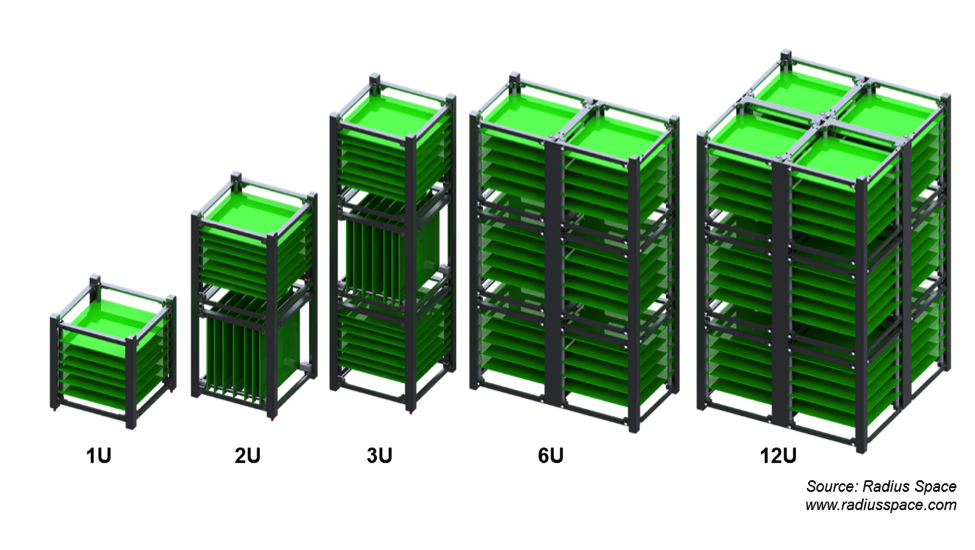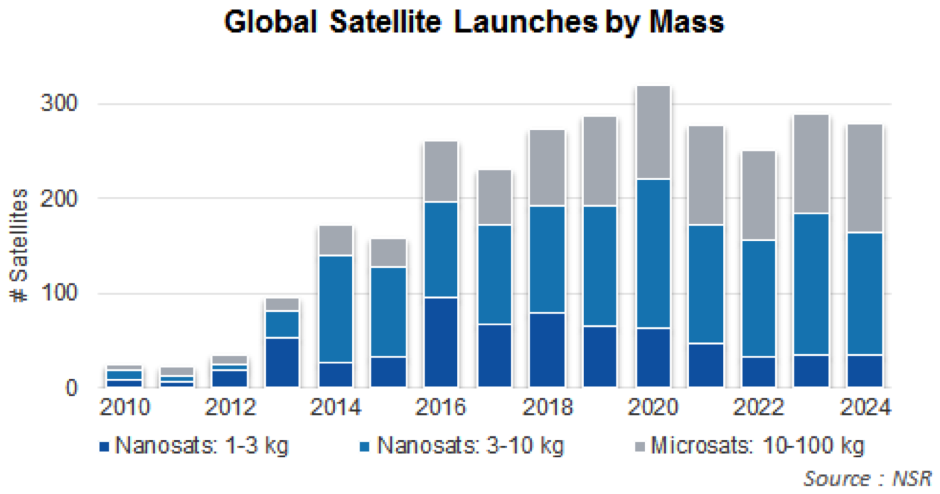Mass Challenge for Cubesats
Jul 6th, 2015 by
Carolyn Belle, NSR
Cubesats emerged in 1999 as a tool for university
STEM education. As their popularity grew, an ecosystem
developed around this form factor and is a key driver of
today’s expanding nanosatellite market. One quarter of
nano and microsatellites launched between 2010 – 2014
were 1 Unit (1U) cubesats (10 cm3), and the
operator pool has grown from universities to commercial,
government, and military players. But as the small
satellite market continues to grow, will 1U cubesats
persist as a standard or be considered inadequate in
favor of larger/more powerful satellites?
Evaluating Utility of the 1U
For small sat operators, mission cost, ability to
leverage COTS components, launch opportunities, and
ultimately payload capabilities drive form factor
decisions. With larger size and greater payload
capabilities generally come increases in cost, timeline,
and mission complexity. Where does the optimal balance
lay?
Cubesat Size Comparison

Few potential users deem 1U satellites too large.
That said, pico and femtosatellites, including the
standardized PocketQube form factor, have been pursued
by educational users as well as amateur radio and space
aficionados. The principal draw thus far is obtaining
space experience within a more manageable scope and
decreased manufacturing and launch price compared to a
full cubesat, and this will lead a small population of
players previously in the 1U target market to turn to
smaller platforms moving forward.
The single largest concern voiced about the 1U form
factor is its limited payload accommodations (mass,
volume, & power). Despite prior commercial and
government missions using the 1U form factor, these
users are expected to opt for larger platforms in the
future. Only one announced commercial venture leverages
a 1U design, and the U.S. National Science Foundation
recently stated that 1U cubesats are simply too small to
accomplish meaningful science. The fastest growing nano
and microsatellite operator community falls into this
category.
The original target user of the 1U cubesat –
universities – are still very much the key market. 1Us
provide the right balance of low costs, limited project
complexity and timeline, and hands-on experience for a
student team and (low) university resources. As
universities gain experience and establish funding
streams that enable them to pursue more ambitious larger
missions, novice universities and even high schools are
emerging to take their place in the 1U operator segment.
Despite plans for the commercial Outernet
constellation using 200 1U cubesats, NSR does not
anticipate full deployment of this system or ongoing use
of this platform for commercial purposes.

NSR’s Nano and Microsatellite Markets, 2nd
Edition found that the 1-3 kg nanosatellite segment –
largely composed of 1U cubesats – will grow at a 3% CAGR
over the next decade. Just over 500 such satellites are
expected to launch by 2024. While this represents
positive growth, it also belies the reduction in market
share of this mass segment: a fall from 38% in 2010 to
12% in 2024.
Rather, the single most active small satellite
segment is expected to be 3-10 kg platforms. Larger
10-100 kg platforms are the most rapidly growing, at a
14% CAGR.
A Preference for Larger Form Factors
In 2014 the 1U cubesat’s larger version, 3U, became
the most prevalent form factor in this market. This was
primarily tied to deployment of the Planet Labs
constellation, but the platform is also integrated in
plans for other commercial systems as well as a steady
stream of government and university science
applications.
While constellations using 3U platforms will sustain
activity in this market through the next decade, NSR
expects the next wave of growth to emerge with 6U and
12U cubesats. These larger cubesats strike a balance
between enabling far more capable payloads but limiting
manufacturing and launch costs and leveraging the
benefits of standardization.
Bottom Line
1U cubesats are a driving force behind today’s
resurgent interest in small satellites. Simplicity and
the concepts of standardization and COTS components
championed through 1U cubesats opened the satellite
market to diverse users, and these same ideas are now
being successfully applied to larger form factors, both
multi-U cubesat and otherwise. Yet, the demand for
increased payload capacity to support diverse
applications and more capable instruments is leading the
market to larger form factors, and leaving 1U platforms
to fulfill their original purpose as an educational
tool. But in this dynamic and rapidly evolving market,
the ongoing march of technology miniaturization could
revive 1U utilization in the 2020s and beyond.